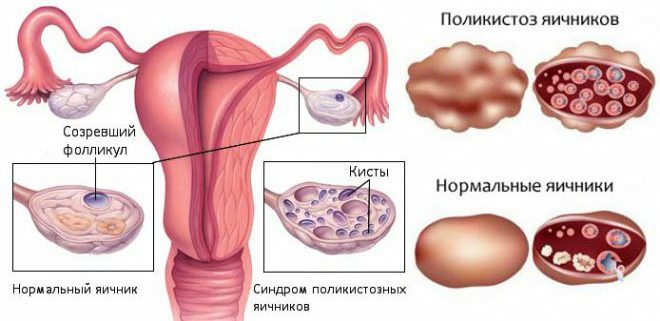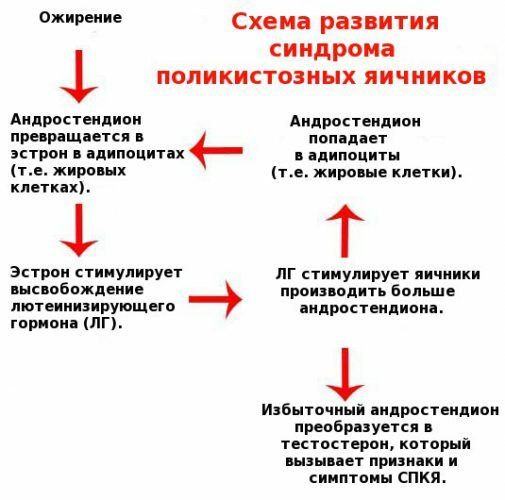Today, more and more often you can hear a depressing diagnosis of "Polycystosis".The increase in the number of women with this pathology is associated with several reasons: an increase in the quality of diagnosis, a real increase in the incidence, an expansion of the concept. Most often, the girl will find out about the problem when she has been planning a pregnancy for some time unsuccessfully. Indeed, the symptoms of the disease are ambiguous, and the treatment is ineffective. Whether it is possible to become pregnant at a polycystosis of ovaries and what for this purpose it is necessary to make?
What is the Danger of PCOS
The main danger of polycystosis is that there is no unified theory about the causes of its occurrence. Consequently, there is no effective treatment.
And the polycystic ultimately entails many problems for a woman: from a tendency to overweight and menstrual cycle disorders to infertility and an increased risk of oncological pathology of the genital organs.Primary or secondary to the girl with the onset of puberty, there is an imbalance of sex hormones and an incorrect response from the pituitary and hypothalamus is formed on them. This can be caused by hyperplasia of the adrenal gland and increased secretion of androgens, or directly problems in the ovaries.
As a result, there is no cyclic production of sex hormones, and this is a prerequisite for the normal maturation of the follicle and ovulation. Soon on the ovaries a dense shell of connective tissue is formed. Underneath it there are many small follicles that once wanted to reach the final stage of their development. The more polycystic is expressed, the clearer the signs are visible with ultrasound examination. Sometimes the ovaries can be compared in structure with honeycombs in bees.
So, the risks of the following diseases are increased significantly in women who have any signs of polycystic ovary:
- Problems with conception. Women with PCOS often have very rare ovulation, sometimes once a year or even none at all. Also, there are difficulties in the growth of the endometrium and its subsequent rejection.
- Obesity. To excess weight leads both directly to hyperandrogenemia, and insulin resistance that occurs in PCOS.Excess kilograms close the vicious circle, increasing the formation of estrogens, from which follow further diseases.
- Violation of glucose tolerance, which significantly increases the risk of developing type 2 diabetes.
- Increased likelihood of endometrial and cervical cancer, as well as all kinds of hyperplastic processes( polyps, etc.).
- Also, with polycystic disease, a number of somatic problems, such as hypertension and many others, gradually appear.

Symptoms of polycystosis
Primary polycystosis, Stein-Leventhal syndrome, as well as a secondary form of the disease can be distinguished. In the latter case, pathology is formed at various neuroendocrinal states - Itenko-Cushing's disease, adrenogenital syndrome, hyperprolactinaemia, and the like. The clinical picture of both has no fundamental differences, there is always a certain symptom or group prevailing.
With the development of changes in the background of other diseases, one should speak of polycystic ovaries, and not of the syndrome as a whole. Since in practice these concepts in most cases are not demarcated, the frequency of diagnosis of "PCOS" has increased in recent years.

Classic PCOS has a fairly vivid clinical picture, but it is much less common. More often you have to face the prevalence of some symptoms.
The following symptoms can be attributed to the main manifestations of PCOS:
- Disorder of the menstrual cycle. In most cases, it is oligomenorrhea, sometimes amenorrhea. With prolonged intervals between menstruations, the discharge may be quite abundant, often with clots. This promotes hyperplasia of the endometrium and the formation of polyps inside the uterine cavity. If you do not follow the state of health and do not perform treatment, then subsequently, endometrial cancer can develop. Another option will be scanty month-by-type opromenorei.
- Violations of ovulation and the menstrual cycle lead to infertility and the need for a different type of treatment for the possibility of conception. When constructing the basal temperature graph, violations are clearly visible. Because almost all women have a question, how to get pregnant with polycystic ovaries.
- Hirsutism of different severity. It can be as an unobtrusive tendril above the upper lip, and significant hair on the chin, inside of the thighs, on the abdomen, mammary glands, etc.
- In 60% of cases, women with PCOS are overweight. This is due to a change in metabolism with the predominance of androgens, which are converted into adipose tissue into estrogens.
- Insulin resistance caused by increased content of male sex hormones in the blood. His blood level in the study exceeds the normal values several times. This can eventually lead to diabetes mellitus, although a long time violation of glucose utilization remains imperceptible.
- Imbalance of sex hormones in the blood by the results of analyzes.
- Enlarged and with many small ovarian cysts.
Look at the video about the disease:
Diagnosis
Diagnosis PCOS is established when three criteria are found. These include:
- disorder of the menstrual cycle of a different nature;
- revealing the increase in male sex hormones in the blood;
- enlarged and altered ovaries by ultrasound.
All other tests and examinations are an addition to the main one for the purpose of the most optimal treatment and choice of tactics for pregnancy planning.

When asked whether it is possible to become pregnant with polycystic ovaries naturally or if some additional intervention is needed( laparoscopy, induction of ovulation, etc.), it is possible to respond only after a comprehensive examination and analysis of the findings.
Treatment of
Treatment of polycystic ovary is based on the use of various drugs of the hormone spectrum, and also affecting metabolism. All this makes it possible to minimize the risks that a woman has with this disease.
A separate item is all the methods used to restore the fertility of a woman, the resumption of ovulation and the realization of pregnancy.
Therapy, which would allow once and for all to cope with the problem, no. This is due to the fact that there are no true causes and all mechanisms for the development of pathology.
It should also be noted that before curing the polycystic ovary to get pregnant, it is necessary to normalize the body weight at least up to a BMI of 27-20 kg / m2.To do this, it is necessary( sometimes under the control of the endocrinologist) to observe a diet and a certain level of physical activity.
Hormonal preparations
Various drugs containing estrogens, androgens or other active substances are widely used in the treatment of polycystosis .They help to some extent balance the hormonal background and to normalize certain processes in the body, which makes it possible for a woman to become pregnant and protect her from many consequences of PCOS.
Oral contraceptives
This is the most commonly assigned group. With the regular intake of hormonal contraceptives, its own level of estrogens and androgens decreases, which is important for the correction of disorders. Against this background, a woman normalizes her menstrual function, regulates the volume of secretions during critical days, symptoms of premenstrual syndrome go away. The most commonly used hormonal contraceptives with anti-androgenic effect, for example, "Diana", "Jess" and the like. The minimum period for their admission is 3 months, the maximum is not limited.
Also in the presence of hyperplastic processes, mastopathy and some other problems, only gestagen-containing contraceptives, mini-pili or Mirena IUD, plasters, etc. are used.
But it should be understood that the problem of polycystic is not solved by taking hormonal contraceptives. They normalize menstrual function only at the time of admission, and a few months after their cancellation, everything returns. Therefore, with PCOS it is recommended to use long-term( for many years) the use of contraceptives with a curative purpose.
Ovulation inductors
If a woman tries unsuccessfully to become pregnant, after the examination, decisions can be made about induction of ovulation in her. In this case, drugs are prescribed that stimulate the growth and maturation of the follicles, the release of the egg from them. Often this is done after performing hysterosalpingography - determining the patency of the fallopian tubes.
There are several groups of drugs, the standard schemes foresee the use of Clomiphene. In the first month, its minimum amount is taken and further, if necessary, the dose can be increased. Unfortunately, with polycystic disease, it is often possible to face the problem of ovarian induction resistant. Then, instead of "Coliphene," similar funds are used, but gonadotropins are involved in the pituitary and hypothalamus.
Classic ovulation induction schemes also include, in most cases, gestagens from 15 to 28 days to maintain the second phase of the cycle. If necessary, treatment is supplemented with estrogens( orally or in the form of creams on the skin).
The entire treatment process should be monitored by ultrasound. If you use this method for polycystic ovaries, you can get pregnant naturally by stimulating ovulation and hormonal correction.
Other drugs
Also often in polycystic, especially in women with overweight, drugs that improve the utilization of glucose by cells are used. This helps to lower the level of blood insulin. Most often, "Metformin"( "Seophore") is used for this. By itself, it does not influence the process of conception, but with its help there is a normalization of many processes in the body, which contributes to the onset of pregnancy. Even the sensitivity of the ovaries to "Klomifen" increases against such therapy.
Laparoscopic techniques of
What to do and how to treat polycystic ovary to get pregnant if induction of ovulation and other treatments does not give the desired result? In this situation, laparoscopic methods of treatment should be used.
Such operations allow solving several questions at once:
- determine if there are other objective reasons that could affect the likelihood of conception;
- check the patency of the fallopian tubes by performing hysterosalpingography;
- if necessary, you can remove fibromatous nodes, cysts, etc.;
- during polycystic laparoscopy partially removes dense belly, or cuts are made on the ovaries, or partial resection occurs, depending on the clinical situation and severity of the disease.
The probability of pregnancy after performing laparoscopy increases several times. After the operation, you should start planning for the nearest ovulation, sometimes even 5 to 7 days after the intervention. Sometimes, in order to increase the chances of conceiving, ovulation can be stimulated additionally.
 We recommend that you read an article about menstruation with polycystic ovaries. From it you will learn about the disease and its effect on menstruation, the length of the cycle in polycystosis, as well as the need for treatment.
We recommend that you read an article about menstruation with polycystic ovaries. From it you will learn about the disease and its effect on menstruation, the length of the cycle in polycystosis, as well as the need for treatment.
Actual questions for expectant mothers
All treatment, especially hormonal, should be prescribed by a doctor. Only a specialist can recommend safe and effective therapy regimens.
But no matter how good the doctor is, patients often have questions that they do not have time to get answers for the time of admission. These include:
- Is pregnancy possible with polycystic ovaries without any treatment or induction?
Yes, the probability of conception is, but sometimes the efforts are stretched for years and even dozens of years. Everything depends on the severity of the disorders and hormonal changes. But it is not necessary to take risks, because with increasing age even reproductive technologies do not give such a high result.
- What is the purpose of hormonal contraceptives if a woman wants to become pregnant?
The fact is that taking oral contraceptives for 3 to 4 months( no longer), then after the withdrawal there is a rebound effect - a sharp increase in the hormones of the pituitary gland, responsible for the growth and maturation of the follicles. Often in such situations, healthy twins are born twins, triplets. With polycystic it acts as a natural stimulation of ovulation.
- Where to start the treatment of polycystosis if there is a desire to become pregnant?
Of course, you should contact a specialist. It can be a reproductive health specialist, gynecologist-endocrinologist or an ordinary doctor of a woman's consultation. Even before the visit, you can build a basal temperature chart for 2 - 3 cycles, make a spermogram to her husband. All further research will be appointed by the doctor as necessary.
- Is Ovulation Stimulation Dangerous?
Indeed, the constant hormonal tremors are not entirely harmless. Therefore, they must be carried out only under the supervision of a specialist. It is well known that with frequent stimulation of ovulation and many attempts of IVF, the risk of ovarian cancer increases. It also affects the work of all organs of internal secretion( thyroid and pancreas, adrenal glands, etc.).They react to hormonal tremors and mammary glands by increasing the frequency and severity of mastopathy.
- What are the other risks in women with polycystosis during pregnancy?
Women with hormonal disorders, including PCOS, are at risk for miscarriage( higher probability of undeveloped pregnancy and premature birth), abnormality of labor, fetal pathology, infectious complications, development of gestational diabetes mellitus and gestosis of different degrees,bleeding( placental abruption, etc.) Therefore, they should always be under the supervision of doctors.
They are more likely to face infertility problems than others. Determine the true cause and prescribe the right treatment( stimulation of ovulation, laparoscopy, etc.) can only specialist after the examination. But sometimes even they do not give an unambiguous answer, whether it is possible to cure polycystic ovaries and become pregnant in a particular situation.


